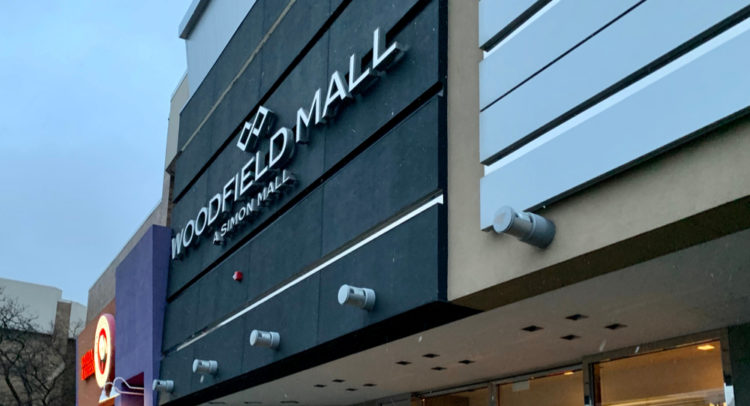Mall-heavy real estate developer Simon Property Group (SPG) may have pulled off a little dose of the impossible with its latest earnings report.
What gave Simon this surprising win? An even more surprising fact: it seems the mall is starting to recover. Under normal circumstances, I would be bearish on most physical retail, but after seeing this, some old narratives are reviving and giving me reason to be bullish on Simon. (See Analysts’ Top Stocks on TipRanks)
Simon has spent most of this year steadily climbing. There have been some minor ups and downs along the way, but the stock has been tracing a steady if somewhat shallow upward slope all year. Simon stock kicked off the year down around the $80 mark, but now, it’s making a serious play for doubling that figure.
If things continue as they have been, by Christmas, Simon investors might well be opening the grandest present of all: $160 shares.
What drove this recent bout of upward momentum? Perhaps the most unlikely news of all: recovery at the mall. Simon posted its third-quarter earnings report and beat expectations throughout the spectrum.
It destroyed analysts’ projections for income, posting $2.07 per share, against expectations of just $1.09. That was also enough to shatter the figures posted this time last year, when the company brought in $0.48 per share.
The company also offered exciting news on its traffic figures. Foot traffic is returning and people are shopping again. In turn, new stores are taking up residency in Simon malls in a bid to take advantage of that growing traffic.
Wall Street’s Take
Turning to Wall Street, Simon Property Group has a Moderate Buy consensus rating, based on nine Buys and four Holds assigned in the past three months. The average Simon Property Group price target of $158 implies 2.4% downside potential.
Analyst price targets range from a low of $136 per share, to a high of $200 per share.

The Old Mall Narratives Return
While 2020 was nothing short of a disaster for malls, and virtually any physical retail, the troubles for such entities didn’t start there. Malls and physical storefronts had been having a rough time of things for years prior.
The rise of Amazon (AMZN) hit physical retail hard, and with good reason. Online retail gave shoppers access to a whole new level of connectivity and convenience. Product reviews were part of every listing. You could tell at a glance how people who bought the thing in question felt about it. At least, until people discovered fake reviews and gamed the system.
About the only thing the mall had going for it was immediacy. No matter how good online shopping was, it still took several days to actually receive your item. Physical shopping let you take the item home that instant. Yet, it was still hard to compete with a platform that had more choices and was as easy to reach as a laptop keyboard.
Malls, facing potential irrelevancy, began to rethink the concept. Malls started to look less at stores and more at experiences. Some malls were adding on to their food courts. Instead of overpriced, lukewarm, greasy treats, some malls started to look to fine dining. Amusement park rides and other thrills joined in, and even some old standards like video arcades started to make limited comebacks.
The mall as a shopping venue was starting to crumble under the weight of online options. Malls, in a bid to survive, began to change accordingly.
The arrival of COVID-19, and the dubious shutdown of economies that followed didn’t help matters. Malls lost most of their business altogether for several months.
With the return of shoppers, though, so too could the old narratives return. Malls could start looking again into adding on to their options and giving customers more than just overpriced clothes.
Concluding Views
The recovery we’ve seen so far has been great. The recovery we might see if Simon sticks to its development guns like we were seeing back in 2019 could be bigger still.
As much as Simon has gained so far this year, there are at least some signs this could continue. The less Simon has to depend on the supply chain for results, the better as well; offering experiences can usually be done without much need for material currently floating off the California coast.
Disclosure: At the time of publication, Steve Anderson did not have a position in any of the securities mentioned in this article.
Disclaimer: The information contained in this article represents the views and opinion of the writer only, and not the views or opinion of TipRanks or its affiliates, and should be considered for informational purposes only. TipRanks makes no warranties about the completeness, accuracy or reliability of such information. Nothing in this article should be taken as a recommendation or solicitation to purchase or sell securities. Nothing in the article constitutes legal, professional, investment and/or financial advice and/or takes into account the specific needs and/or requirements of an individual, nor does any information in the article constitute a comprehensive or complete statement of the matters or subject discussed therein. TipRanks and its affiliates disclaim all liability or responsibility with respect to the content of the article, and any action taken upon the information in the article is at your own and sole risk. The link to this article does not constitute an endorsement or recommendation by TipRanks or its affiliates. Past performance is not indicative of future results, prices or performance.









